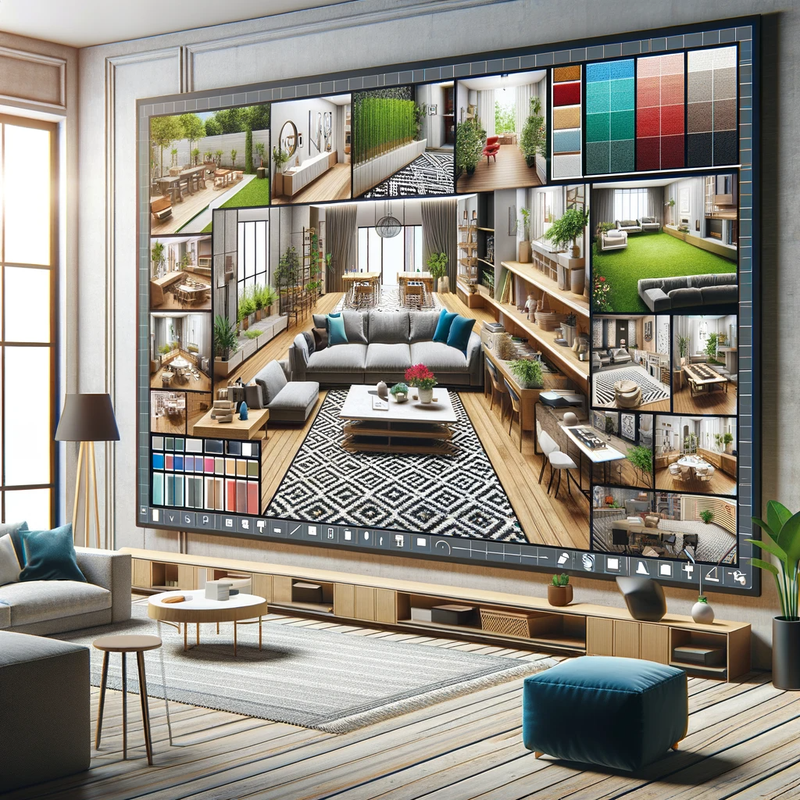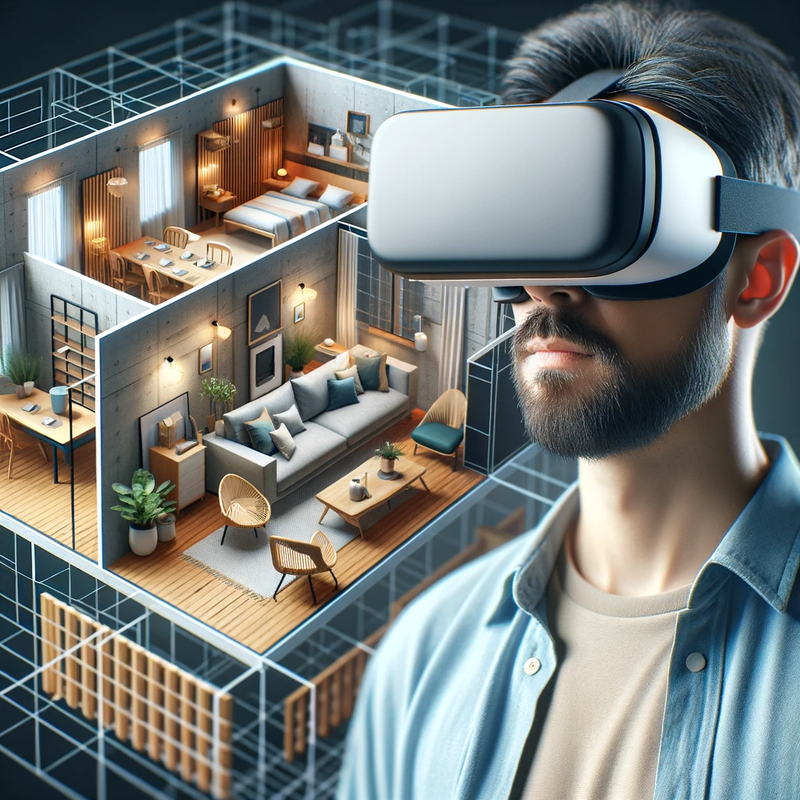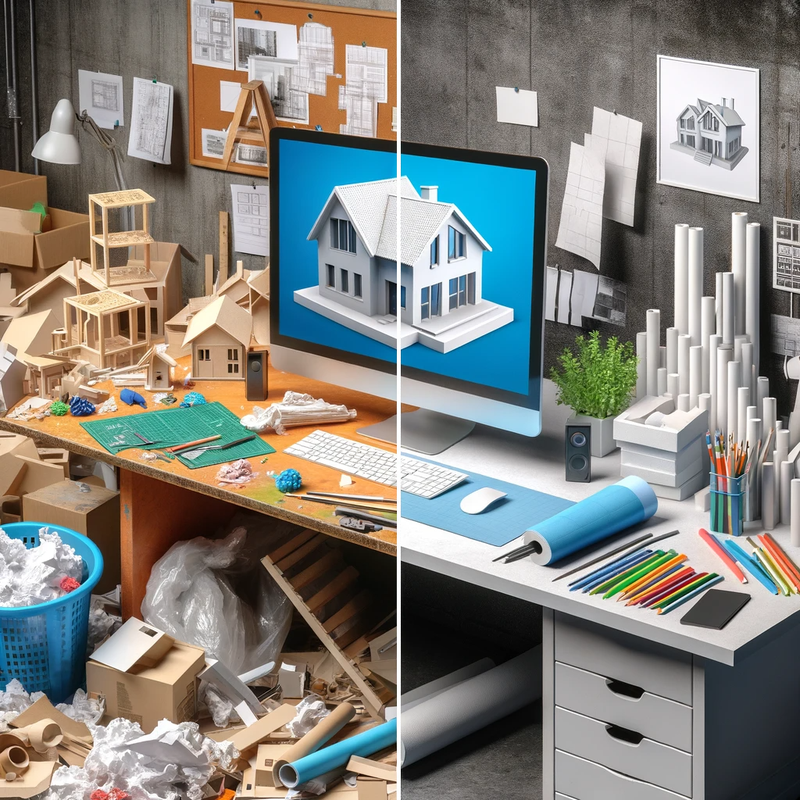10 Benefits of 3D House Rendering in Modern Architecture and Real Estate
In the ever-evolving world of design and real estate, the quest for more transparent, more vivid, and precise representations of architectural concepts has led to the rise of 3D house rendering. At its core, 3D house rendering is a digital technique that transforms architectural designs into three-dimensional models, granting a lifelike perspective of a property even before the foundation is laid. As we delve deeper into this technological marvel, its contributions to modern architecture and real estate are indispensable.
1. Enhanced Visualization

The realm of architecture is a blend of art and science. Architects conjure up designs that are both aesthetically pleasing and functionally efficient. But, traditional two-dimensional blueprints, though valuable, often cannot capture the depth, texture, and spatial relationships inherent in these designs. Enter 3D house rendering. With this technology, architects have a tool that literally and figuratively adds an extra dimension to their designs.
Imagine viewing a house as a flat sketch on paper and a virtual construct, complete with shadows, textures, and an essence of realism. 3D rendering brings these architectural designs to life, enabling one to take virtual 'walks' around and inside the property. The walls have depth, the gardens bloom and the interiors showcase the dance of light and space–all on a digital platform.
For architects, this tool is revolutionary. It means they can iterate and visualize multiple versions of their designs quickly, playing with distinct elements without the constraints of physical models. They can examine their designs from all angles, ensuring that every corner and niche is just right.
Conversely, clients no longer need to stretch their imagination to visualize their dream homes. A common challenge in the architect-client relationship is the disconnect between what the designer visualizes and what the client perceives. 2D plans, while detailed, demand a certain visualization from the viewer. For those untrained in architectural reading, this can be daunting. The 3D-rendered model bridges this gap. When clients can see a realistic rendition of their future home or property, they gain a clearer understanding, can make informed decisions, and even provide more accurate feedback.
This visualization is not just about aesthetics. It clarifies spatial arrangements, room sizes, and how different house elements harmonize. This clarity is invaluable for someone investing time, emotions, and finances into a property.
2. Improved Design Accuracy
In any architectural endeavour, precision is paramount. It's not just about crafting a beautiful structure, but also ensuring that this structure stands tall, functional, and safe. One of the primary benefits of 3D house rendering is the gift of precision it brings to the design table. By transitioning from 2D sketches to 3D models, architects are given a much clearer perspective of their design's spatial relationships, dimensions, and overall flow.
With a 3D model, it becomes exponentially easier to spot potential issues or inconsistencies. Maybe a particular wall is intruding into what should be an open space, or perhaps the play of sunlight during a specific time of day casts an unwanted shadow over an essential living space. When overlooked, These minute details can lead to expensive and time-consuming corrections during the construction phase. By identifying these problems early on through a rendered model, architects can amend the design ensuring a smoother construction process.
The monetary implications of this accuracy cannot be overstated. Rectifying design flaws post-construction disrupts the agreed timeline and escalates the budget. The costs associated with labour, materials, and halted construction timelines because of unforeseen design changes can be burdensome. 3D rendering safeguards against these potential pitfalls, saving both time and financial resources.
3. Customization Opportunities

Every individual or family has a unique vision of their ideal home. While some may dream of a serene, minimalist abode, others might envision a vibrant house teeming with colours and textures. Traditionally, the journey from conception to realization of these dreams has been long, laden with challenges and compromises. However, 3D house rendering is changing this narrative, offering unlimited customization opportunities with unparalleled ease.
With 3D rendering software, design element changes are only a few clicks away. Want to see how the living room looks with wooden flooring instead of tiles? Or perhaps you're contemplating between a pastel shade for the bedroom walls versus a more vibrant hue? With traditional methods, each change would require a design rework or, at the very least, a vivid imagination. But with 3D rendering, we can visualize almost instantaneously these changes.
This flexibility extends beyond just colours. Structural elements, furniture placements, finishes, and even landscaping options can be easily swapped, changed, and rearranged. For architects and designers, this means that they can offer multiple design variations without extensive rework. Clients can explore different themes, palettes, and layouts until they find one that resonates with their vision.
This transformative approach also eliminates the physical limitations and costs of creating multiple mockups or sample rooms. In the virtual world of 3D rendering, customization is both effortless and cost-effective.
3D house rendering is a technological tool and a medium that empowers architects and clients alike. It fosters precision and creativity, ensuring that the last structure is not just a building, but a well-realized dream. As the realms of design and technology continue to intertwine, it's exciting to envision the endless possibilities that tools like 3D rendering bring to the horizon.
4. Effective Marketing and Presentation

In a world driven by digital media and visual storytelling, how a product or service is presented can significantly influence its success. This holds especially true in real estate and architecture, where the potential of a property or design needs to captivate a viewer almost instantly. Enter the domain of 3D house rendering, a game-changer in the world of marketing and presentation.
For architects and designers, a portfolio is more than just a collection of past projects; it's a testament to their skill, creativity, and vision. By incorporating 3D renderings into their portfolios, professionals can showcase their designs fully. The depth, the play of light and shadow, and the intricate details all come to life, allowing potential clients to experience, rather than just view, a project. This enhanced display enriches the portfolio and sets the professional apart in a competitive market.
For real estate agents and developers, 3D rendering can be an invaluable sales tool. Consider a potential homebuyer looking at a yet-to-be-constructed property. Traditional blueprints or 2D layouts often leave much to the imagination. However, a 3D-rendered model allows the buyer to visualize the final product. They can see how the morning sun floods the living room, how the backyard looks at dusk, or how the interiors could be decorated. This lifelike visualization can evoke an emotional connection, making it easier for potential clients or buyers to decide. 3D rendering allows them to see not just a house, but a potential home.
5. Cost Efficiency
While the aesthetic and experiential benefits of 3D house rendering are clear, one of its more subtle, yet profound advantages lies in its potential for cost savings. At first glance, investing in 3D rendering might seem like an additional expenditure, but its cost-effective nature becomes apparent when we delve deeper.
In the traditional design process, any significant change or revision often caused the creation of physical mockups or sample rooms. These required not only materials but also additional labour and time. Even minor tweaks could lead to substantial costs. With 3D rendering, these physical iterations are largely eliminated. Big or small changes can be made digitally, allowing for unlimited revisions without the associated material costs.
The visual clarity that 3D rendering provides can significantly streamline decision-making processes. When stakeholders, be they clients, investors, or regulatory authorities, have a clear visual representation, the back-and-forth typically associated with approvals is minimized. Everyone is on the same page, literally. This can expedite project timelines, ensuring that projects are completed faster, which can lead to monetary savings.
In addition, costly rectifications during the construction phase are reduced by preemptively identifying design flaws or inconsistencies (as mentioned in the earlier sections). This proactive approach ensures a smoother construction process and translates to direct cost savings.
6. Easy Integration with VR and AR

The technological landscape is ever-evolving, with virtual reality (VR) and augmented reality (AR) emerging as frontrunners in shaping the future of various industries, including real estate and architecture. 3D house rendering, given its inherent digital nature, beautifully dovetails with these advancements, offering even more interactive and immersive experiences.
Imagine, as a client, not just viewing a 3D model on a screen but actually 'walking' through your future home, experiencing every nook and cranny, through the lens of VR. This level of immersion is what VR integration with 3D rendering offers. It elevates the entire design presentation process to an experiential level, allowing clients or stakeholders to feel the space truly. They can get a sense of the scale, the ambiance, the lighting, and even the potential furnishings, making design evaluations and decisions much more intuitive.
AR, conversely, superimposes the digital model onto the real world, offering a blend of reality and digital precision. This can be beneficial for renovations or extensions, where a client can see how the new design integrates with the existing structure.
Interactive walkthroughs, made possible by integrating 3D rendering with VR and AR, impress clients and empower them. They can provide real-time feedback, ask for changes, and decide on the spot, making the entire design and approval process smoother and more efficient.
7. Environmental Benefits

In an age where sustainability is not just a buzzword but a necessity, every industry is looking for ways to minimize its environmental footprint. Historically known for significant material usage and waste, the architectural and construction sectors are no exception. Here, 3D house rendering emerges as an unlikely, yet potent, ally in the quest for sustainability.
Foremost, the digital nature of 3D rendering significantly reduces the need for physical models. Traditional architectural practices often required multiple models to be crafted, each iteration consuming materials and eventually leading to waste. With 3D models, these iterations are all digital, decimating material usage and associated waste.
Beyond the modelling phase, 3D renderings also play a pivotal role during construction. As previously mentioned, the precision and clarity of these models can help identify design inconsistencies or potential issues upfront. Addressing these issues before construction begins means fewer changes during the actual build, reducing waste associated with construction modifications.
3D rendering can also be a tool to promote sustainable design practices. With accurate simulations, architects can assess the energy efficiency of a design, understand how natural light interacts with the space, or even evaluate the efficiency of HVAC systems. This allows for the creation of designs that not only look good but are also in harmony with the environment.
Digital presentations and meetings, facilitated by 3D renderings and their integration with VR and AR, can reduce the carbon footprint associated with travel. Clients and stakeholders can experience and approve designs from the comfort of their locations, making the entire process efficient and eco-friendly.
8. Boosting Stakeholder Communication
In any architectural or construction project, seamless communication among stakeholders is paramount. The complex nature of these endeavours requires architects, designers, contractors, and clients to be in sync, understanding the vision and intricacies with uniform clarity. 3D house rendering is a potent facilitator for enhancing stakeholder communication.
Traditionally, 2D blueprints, sketches, and verbal explanations formed the backbone of design presentations and discussions. However, these often left room for interpretation, leading to varied perceptions among different stakeholders. A contractor might perceive a design element differently from a client, or an architect's envisioned spatial arrangement might not resonate clearly with a designer. Such disparities can lead to costly and time-consuming misalignments during the execution phase.
Enter 3D rendering. Converting abstract ideas and 2D sketches into tangible, lifelike representations bridges the communication gap. Every stakeholder can view the design in its three-dimensional glory, understanding spatial relationships, material placements, and design intricacies with unparalleled clarity. This visual uniformity ensures that everyone, from the architect to the client, is on the same page, thus avoiding potential misunderstandings or misinterpretations.
3D renderings also facilitate more constructive feedback. Clients can articulate their preferences or concerns more effectively when they have a clear visual to reference. Similarly, contractors can highlight potential construction challenges, and designers can suggest enhancements, all while referring to a familiar visual framework.
9. Speeds up Approval Processes
Every architecture and real estate professional understands the importance and, often, the challenges associated with obtaining approvals. Whether it's a client's nod for a design or regulatory authorities giving the green light, the approval phase can be tedious riddled with multiple meetings, revisions, and delays.
3D house rendering offers a significant advantage in this domain, streamlining and expediting the approval process. When clients or regulatory bodies are presented with a 3D visualization, they gain an immediate and comprehensive understanding of the project. Unlike 2D blueprints that require interpretation and imagination, 3D renderings present a lifelike depiction, leaving little to ambiguity.
This means clients can visualize the outcome, making it easier to give approvals or provide precise feedback for modifications. There's a significant difference between trying to understand a space from flat drawings and actually 'seeing' it in a three-dimensional format. This clarity reduces the back-and-forth often associated with client approvals.
Regulatory authorities can benefit from the accuracy and detail that 3D renderings provide. They can more efficiently assess compliance with building codes, environmental considerations, and other regulations. With everything laid out clearly, there's less need for extensive reviews or multiple clarifications.
Integrating 3D rendering with other digital tools can further speed up the process. Virtual meetings, where stakeholders can collaboratively view and discuss the 3D model in real time, can significantly reduce the need for physical meet-ups, leading to quicker decision-making.
10. Competitive Advantage
In a market flooded with professionals vying for attention, differentiation becomes paramount. The real estate and architectural sectors are no strangers to this competition. From architects and designers presenting their unique visions to real estate agents showcasing properties, standing out in this saturated market can be daunting. Another noteworthy benefit of 3D house rendering–it offers a significant competitive advantage.
The transition from traditional 2D blueprints to intricate 3D renderings is more than just a shift in presentation format; it signifies a commitment to modernity, innovation, and client-centricity. When professionals present their designs or properties using 3D renderings, they immediately signal to clients their forward-thinking approach and their investment in delivering the best visual experience.
Clients, be they homeowners, investors, or developers, are becoming increasingly discerning. Their exposure to global trends and technologies has raised their expectations. Offering them lifelike, immersive visualizations through 3D renderings meets these heightened expectations and often exceeds them. It creates a memorable impression, making professionals leveraging this technology more memorable and appealing.
In a competitive scenario where two professionals offer similar designs or properties, the one using 3D rendering for presentation will invariably have the edge. It reflects not just the quality of work but also the dedication to leveraging the best tools to communicate a vision.
Conclusion
The architectural design and real estate marketing world is transforming, with 3D house rendering standing at its epicentre. As we've journeyed through the multitude of benefits, ranging from enhanced visualization and stakeholder communication to environmental considerations and competitive advantages, the significance of this technology becomes palpable.
3D rendering, while a marvel of digital innovation, offers tangible real-world advantages. It bridges the gap between abstract concepts and tangible realities, streamlines processes, enhances communication and provides a pathway to sustainable and efficient design and construction practices. As it melds aesthetics with pragmatism, professionals embracing this technology are not just staying current but shaping the future.
The time is ripe for those who have yet to explore the realm of 3D house rendering. Whether you're a professional looking to elevate your presentations or a client aiming for a deeper understanding of your dream home or investment, delving into 3D rendering services or software is a step towards a more vivid, efficient, and sustainable future in architecture and real estate.
To our esteemed readers, we encourage you to share your insights, experiences, or feedback regarding 3D house rendering. Whether you've used it, experienced its wonders as a client, or are just curious about its potential, your perspectives enrich the conversation. Let’s continue this dialogue, celebrating innovation and envisioning a brighter design and real estate future.
Our Services
View some of our most popular services below.











